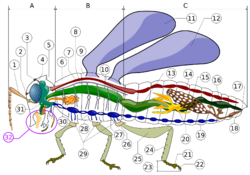Biology:Ventral nerve cord


The ventral nerve cord is a major structure of the invertebrate central nervous system. It is the functional equivalent of the vertebrate spinal cord.[2] The ventral nerve cord coordinates neural signaling from the brain to the body and vice versa, integrating sensory input and locomotor output.[1] Because arthropods have an open circulatory system, decapitated insects can still walk, groom, and mate—illustrating that the circuitry of the ventral nerve cord is sufficient to perform complex motor programs without brain input.[3]
Structure
The ventral nerve cord runs down the ventral ("belly", as opposed to back) plane of the organism. It is made of nervous tissue and is connected to the brain.
Ventral nerve cord neurons are physically organized into neuromeres that process signals for each body segment.[4] Anterior neuromeres control the anterior body segments, such as the forelegs, and more posterior neuromeres control the posterior body segments, such as the hind legs. Neuromeres are connected longitudinally, anterior to posterior, by fibrous nerve tracts called connectives. Pairs of hemisegments, corresponding to the left and right side of the ventral nerve cord, are connected horizontally by fibrous tracts called commissures.[4][5]
In the small worm Meara stichopi there is a pair of dorsal nerve cords instead.[6]
Function
Like the vertebrate spinal cord, the function of the ventral nerve cord is to integrate and transmit nerve signals. It contains ascending and descending neurons that relay information to and from the brain, motor neurons that project into the body and synapse onto muscles, axons from sensory neurons that receive information from the body and environment, and interneurons that coordinate circuitry of all of these neurons.[3] In addition to spiking neurons which transmit action potentials, some neural information is transmitted via non-spiking interneurons. These interneurons filter, amplify, and integrate internal and external neural signals to guide and control movement and behavior.[7]
Evolution
Ventral nerve cords are found in some phyla of the bilaterians, particularly within the nematodes, annelids and the arthropods. Ventral nerve cords are well-studied within insects, have been described in over 300 species covering all the major orders, and have remarkable morphological diversity. Many insects have a rope-ladder-like ventral nervous cord, composed of physically separated segmental ganglia. In contrast, in Drosophila, the thoracic and abdominal neuromeres are contiguous and the whole ventral nerve cord is considered to be one ganglion.[5] The presumed common ancestral structure is rarely observed; instead the ventral nerve cords of most insects show extensive modification as well as convergence. Modifications include shifts in neuromere positions, their fusion to form composite ganglia, and, potentially, their separation to revert to individual ganglia.[4] In organisms with fused neuromeres, the connectives are still there but are very reduced in length.[4]
Development
The insect ventral nerve cord develops according to a body plan based on a segmental set of 30 paired and one unpaired neuroblasts.[8] A neuroblast can be uniquely identified based on its position in the array, its pattern of molecular expression, and the suite of early neurons that it produces.[9][10] Each neuroblast gives rise to two hemilineages: an "A" hemilineage characterized by active Notch signalling, and a "B" hemilineage characterized by an absence of active Notch signalling.[11] Research in the fruit fly D. melanogaster suggests that all neurons of a given hemilineage release the same primary neurotransmitter.[12]
Engrailed is a transcription factor that helps regulate the gene frazzled in order to separate neuroblasts during embryonic development. The segregation of neuroblasts is essential for the formation and development of the ventral nerve cord.[13]
See also
- Dorsal nerve cord in chordates
- Supraesophageal ganglion, the arthropod "brain"
- Nerve net in cnidaria and echinodermata phyla
- Hemichordates, who have both dorsal and ventral nerve cords
References
- ↑ 1.0 1.1 "Mechanosensation and Adaptive Motor Control in Insects". Current Biology 26 (20): R1022–R1038. October 2016. doi:10.1016/j.cub.2016.06.070. PMID 27780045.
- ↑ Animal Diversity (4th ed.). New York: McGraw Hill. 2007. ISBN 978-0-07-252844-2.
- ↑ 3.0 3.1 "The development and assembly of the Drosophila adult ventral nerve cord". Current Opinion in Neurobiology 56: 135–143. June 2019. doi:10.1016/j.conb.2019.01.013. PMID 30826502.
- ↑ 4.0 4.1 4.2 4.3 "Diversity and evolution of the insect ventral nerve cord". Annual Review of Entomology 53 (1): 253–271. 2008. doi:10.1146/annurev.ento.52.110405.091322. PMID 17803455.
- ↑ 5.0 5.1 "A Systematic Nomenclature for the Drosophila Ventral Nerve Cord". Neuron 107 (6): 1071–1079.e2. September 2020. doi:10.1016/j.neuron.2020.08.005. PMID 32931755.
- ↑ "Convergent evolution of bilaterian nerve cords". Nature 553 (7686): 45–50. January 2018. doi:10.1038/nature25030. PMID 29236686. Bibcode: 2018Natur.553...45M.
- ↑ "Central processing of leg proprioception in Drosophila". eLife 9: e60299. December 2020. doi:10.7554/eLife.60299. PMID 33263281.
- ↑ "From grasshopper to Drosophila: a common plan for neuronal development". Nature 310 (5974): 203–207. 1984. doi:10.1038/310203a0. PMID 6462206. Bibcode: 1984Natur.310..203T.
- ↑ "Neuron hemilineages provide the functional ground plan for the Drosophila ventral nervous system". eLife 4: e04493. July 2015. doi:10.7554/eLife.04493. PMID 26193122.
- ↑ "Evolution of neuroblast identity: seven-up and prospero expression reveal homologous and divergent neuroblast fates in Drosophila and Schistocerca". Development 121 (12): 3989–3996. December 1995. doi:10.1242/dev.121.12.3989. PMID 8575299.
- ↑ "Role of Notch signaling in establishing the hemilineages of secondary neurons in Drosophila melanogaster". Development 137 (1): 53–61. January 2010. doi:10.1242/dev.041749. PMID 20023160.
- ↑ "Neurotransmitter identity is acquired in a lineage-restricted manner in the Drosophila CNS". eLife 8: e43701. March 2019. doi:10.7554/eLife.43701. PMID 30912745.
- ↑ "Engrailed controls the organization of the ventral nerve cord through frazzled regulation". Developmental Biology 301 (2): 542–554. January 2007. doi:10.1016/j.ydbio.2006.10.019. PMID 17126316.
External links
 |

